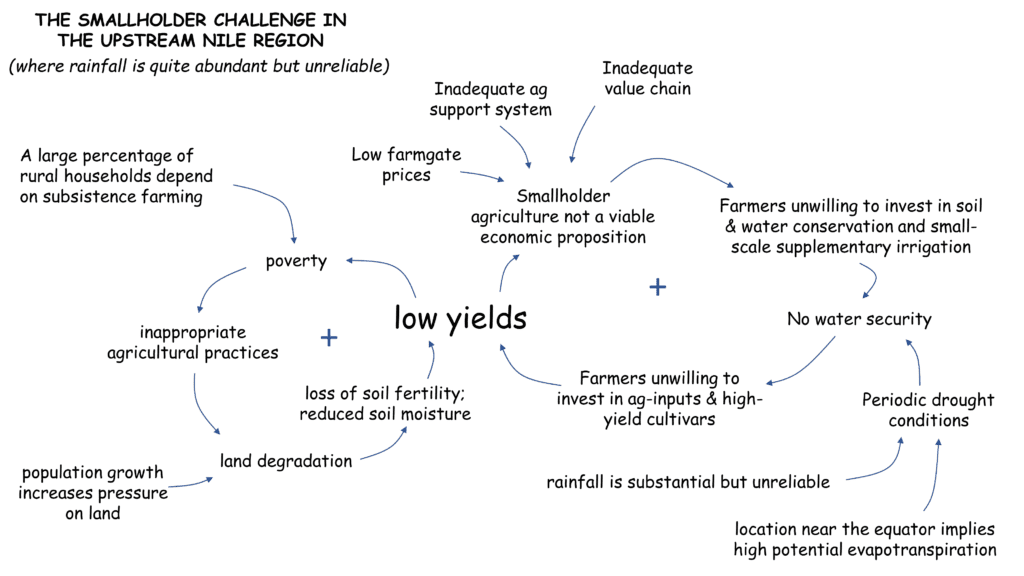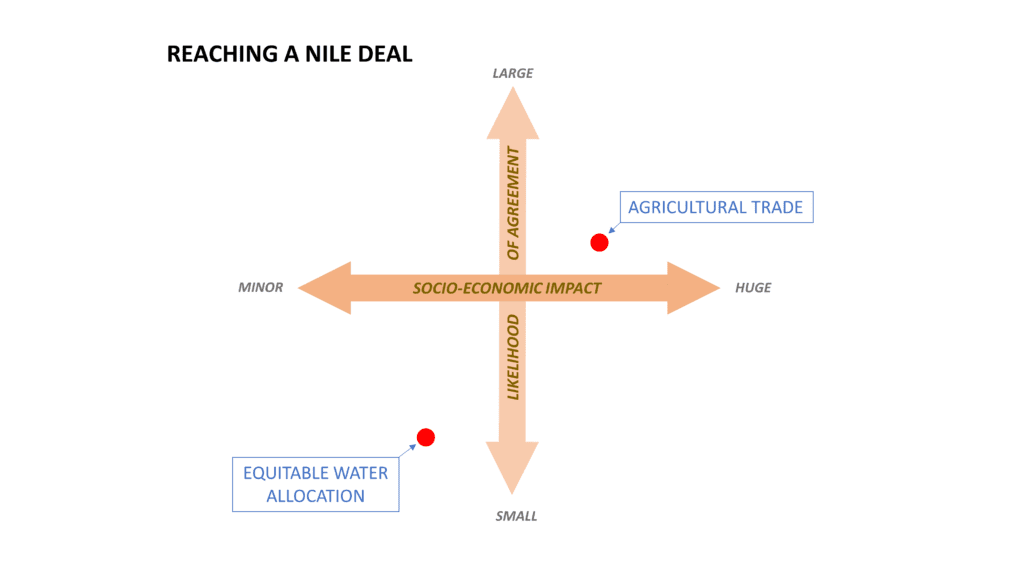The other day I watched an interview with Peter Drucker by Michelle Hunt. It must have taken place in the late 1980s but is still highly watchable. The following sentence struck a chord:
“If you have no results, check all your assumptions”
It carried my thoughts to the Nile basin. Afterall, more than 20 years of painstaking negotiations and impressive efforts by the Nile Basin Initiative (NBI) have not yet resulted in an agreement on equitable use of the Nile waters. In fact, things appear to regress in the last few years.
Thus, maybe time to check the assumptions.
The Case of the Nile Basin
The current negotiations on the Nile waters are based on two implicit assumptions: 1) a basin-wide perspective is necessary, and 2) agreed-upon water allocation is a central part of the solution to the Nile conundrum.
Upon reflection, I think both assumptions are questionable.
A third false or questionable assumption may be related to the availability of political will to find a solution. But I will leave that one to the political scientists.
| The Nile Issue in a Nutshell Condensing the Nile challenge in just four points obviously necessitates a huge simplification; but I will give it a try. First: for the upstream countries it is not about the Nile waters per se; rather, it is about the intractable rural development challenge, which will require agricultural modernization because of the large rural population that intimately depends on the natural resource base for its livelihood and food security; the rural population will remain large until 2050 and beyond, despite rapid urbanization. Note that the agricultural sector is by far the largest water user (>90% of total water use if rain is included). Second: just a fraction of rainfall over the Nile basin reaches the Nile system. For the large White Nile catchment, this is about 4-6%. It is higher for the Blue Nile catchment at approximately 15%. Because of this generally low ‘runoff coefficient’—in combination with the arid climate in Egypt and most of Sudan—the Nile is in fact a small river in terms of volume of discharge, despite its famous name. Some 85% of the (meagre) Nile waters originate in Ethiopia. Third: the productivity of the large volume of rainfall that never enters the Nile system is low. This water is mostly used for pastoralism and rainfed agriculture. Both are characterized by low yields—thus implying a (very) high yield gap. Occasional droughts are among the principal reasons for these low yields. While rainfall is quite substantial, it is characterized by high temporal variability—within the season and within the years. Moisture deficits at critical points during plant grow adversely impact on yields and can even destroy a crop. Farmers know this and take no risks. However, the moisture deficits—though critical—are usually quite small, and water security can often be achieved with small-scale supplementary irrigation from local water sources that do not involve large volumes of water. It aims to increase the productivity of rainfall rather than to establish full irrigation. A similar analysis can be made for the pastoralist livelihood system. But—and this a big ‘but’—absence of water security is not the only constraint in the agricultural production system. Four: smallholder agriculture in the upstream Nile region is currently not a viable economic proposition. Farmgate prices are too low and do not warrant investments—by farmers themselves—in soil and water conservation and infrastructure for supplementary irrigation that would provide water security. And without water security, investments in agricultural inputs such as fertilizer and improved seeds and cultivars are too risky because all can be lost in the inevitable drought. In addition, the current state of the agricultural support system and value chain are inadequate for creating an enabling environment for agricultural modernization based on profitable small-scale agriculture. It has created a vicious circle that entrenches the large yield gap and associated rural poverty. |

Questionable assumption 1: the need for a basin-wide perspective
For addressing the Nile challenge, a basin-wide perspective is perhaps both too big and too small. It is too small because it cannot address the non-water constraints in the agricultural production system—which have proven critical—since these are within the mandate of the nation state. At the same time, a basin-wide perspective is too big because it complicates the Nile negotiations by involving 11 independent states, rather than the three key players: Egypt, Ethiopia, and Sudan. Afterall, for the large White Nile region, achieving water security in the agricultural sector involves making better use of the abundant but unreliable rainfall, which, only to a minor extent, depends on water that reaches the Blue-White Nile confluence in Khartoum.
Questionable assumption 2: water allocation needs to be at the center of the Nile negotiations
Let’s do a thought experiment to investigate assumption 2.
Imagine that the downstream countries Egypt and Sudan—who together use most of the Nile waters—give up a total of 10 BCM (1 BCM = 1 cubic kilometer). Note: this is just a thought experiment. This would require a huge adjustment to their irrigation sectors and, beyond a doubt, lead to huge opposition from farmers. Hence, implementing this proposition would be extremely difficult from a domestic political point of view. In addition, it would involve a complex bi-lateral negotiation about how to distribute this 10 BCM ‘loss’ over the two countries. All very difficult.
At the same time, 10 BCM distributed over the other 9 countries would not really make a difference regarding the complex rural development challenge—which is their key concern. Afterall, achieving water security in the dominant rainfed agriculture sector depends on making better use of the substantial but unpredictable rainfall. Nile waters do not really play a role in this endeavor (see the discussion above on Assumption 1). Nevertheless, the distribution of the 10 BCM over the 9 countries will probably lead to a massively complex—and potentially contentious—negotiation. With rather minor overall impacts on their national economies.
Now imagine an agreement on long-term agricultural trade in the Nile basin, which would lead to (and deliberately target) higher farmgate prices in the upstream region. For sure, this would make a difference regarding the complex rural development challenge. In addition, such an agreement would be much easier to achieve compared to negotiations on water allocation.
The above thought experiment is illustrated in the below figure. It presents a two-dimensional ‘negotiation’ space defined by two axes: 1) socio-economic impact, and 2) likelihood of agreement. While the ‘water allocation’ deal will be extremely hard to reach and has relatively minor impacts on the upstream economies, a trade deal is both easier and more impactful.

The above figure confirms the following observation: while water is certainly the root cause of the Nile issue, the solution is not necessarily in the water domain. Thus, perhaps we have been focusing our efforts on the wrong activities for a while.
If you would ask me—for what it is worth—the right question in the Nile Basin is: “how do we get rural development in the upstream countries”.
Asking the Right Question
The above analysis underscores a discussion I recently had with an old friend. He mentioned that “asking the right question is the obvious start to getting the right answer”. A truism—yes. Yet one that seems often forgotten. Peter Drucker hints to it in many of his quotes:
“Doing the right thing is more important than doing the thing right” (Peter Drucker)
“There is nothing so quite useless as doing with great efficiency something that should not be done at all” (Peter Drucker)
I think this advice—make sure ‘to ask the right question’—specifically applies to the water sector since it is so complex. Water is related to almost everything; and almost everything is related to water. Figuring out how this complex hydrological-environmental-agricultural system works is difficult. It is easy to lose sight of the target. Or adopt a reductionist approach and get the wrong answer.
It is prudent policy, under any circumstances, to carefully check your assumptions before designing a project. But this is even more true in an environment where (budgetary and managerial) resources are scarce—as they are in many countries. Here there are few second chances if you get things wrong from the start.
This blog focuses on managing water when you do not have lots of resources—in terms of budget, staff, data, models, etc. Make (absolutely) sure to solve the right problem is a key principle in this environment. It may sound obvious, but it is not. Thus, check your assumptions!
Scenario thinking has proved effective in mapping the complex contextual environment in the water sector—see a separate blog post on this topic.
One more remark by Peter Drucker in his interview with Michelle Hunt: “The most important thing a young surgeon has to learn is to have a diagnosis before he amputates”.
REFERENCES:
Brichieri-Colombi, S: The World Water Crisis: The Failure of Resource Management; ISBN 978 1 84511 735 5; London, 2009
Hilhorst, B; Water Management in the Nile Basin: A Fragmented but Effective Cooperative Regime; Georgetown University Qatar; Occasional Paper No 17; ISSN 2072-5957, 2016
Bart Hilhorst is a water resources engineer who has worked for more than 20 years in the Nile Basin. He served as Chief Technical Advisor on a basin-wide FAO project that looked into the relations between the water and agricultural sectors. Further, among many other projects in the Nile basin, Bart Hilhorst coordinated the preparation of the State of the Nile Basin Report 2012 and wrote some 70+ percent of the State of the Nile Basin Report 2021.
